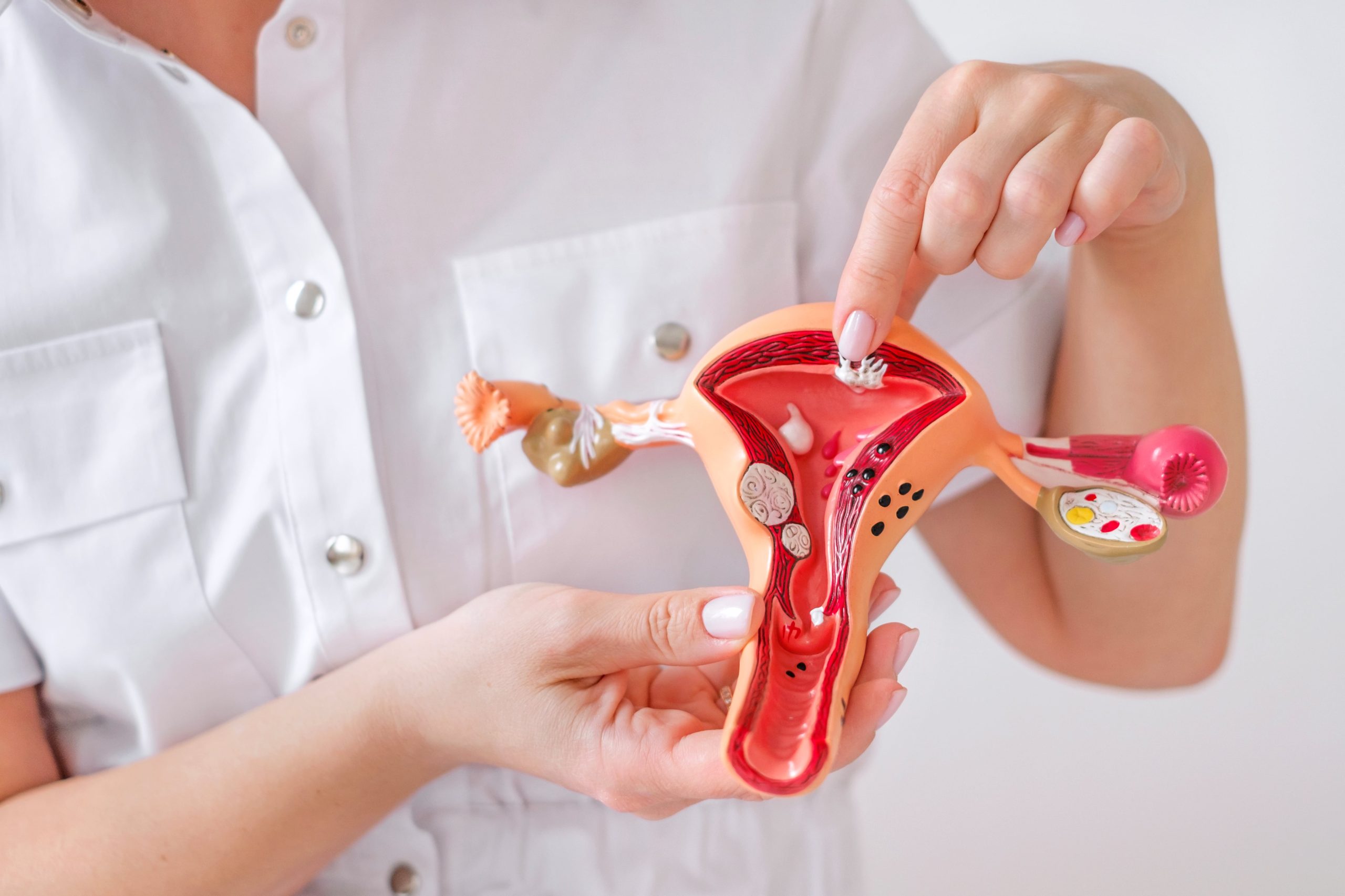Uterus Fibroids Treatment & Surgery in Singapore
Home Gynaecology Uterus Fibroids Treatment & Surgery in Singapore
Uterine fibroids are a common concern for many women, yet they often go unnoticed until symptoms start to interfere with daily life. These growths in the uterus, although non-cancerous, can cause discomfort, heavy periods, and even fertility issues.
If you’ve recently been diagnosed with fibroids or suspect you may have them, you may be wondering what your options are.

What Are Uterine Fibroids?
Uterine fibroids develop inside the uterus and are benign tumours. They grow to varying sizes, from tiny, seed-like growths to large masses that can disfigure the uterus. Many women with fibroids experience no symptoms, while others may have heavy menstrual bleeding, pelvic pain, bloating, or frequent urination due to pressure on the bladder.
What Causes Fibroids in the Uterus?
Hormones and genetics are significant in the development of fibroids.
Fibroids grow in response to oestrogen and progesterone, the two main hormones that balance the menstrual cycle. These hormones not only stimulate the growth of the uterine lining each month but also encourage fibroid development. This is why fibroids shrink after menopause when hormone levels naturally decrease.
Genetics may also contribute to fibroid development. If your mother, sister, or other close relatives have had fibroids, your risk of developing them is higher. Certain inherited genetic mutations may make some women more prone to developing these benign tumours.
What Are the Risk Factors for Uterine Fibroids?
While fibroids can develop in any woman of reproductive age, some factors increase the likelihood:
-
Age
Fibroids are most common in women in their 30s and 40s. -
Family History
A close relative with fibroids increases your risk. -
Ethnicity
Asian women are more likely to get fibroids younger and have more severe symptoms.
-
Obesity
A higher body fat percentage can lead to higher oestrogen levels, which may promote fibroid growth. -
Diet and Lifestyle
A diet with high intake of red meat and less vegetables has been linked to a greater risk of fibroids.
How Are Uterine Fibroids Diagnosed?
If you suspect you have fibroids, a gynaecologist in Singapore will begin with a pelvic exam. This routine examination allows the doctor to check for an enlarged or irregularly shaped uterus, which may indicate the presence of fibroids. However, because fibroids are often difficult to detect through a physical exam alone, further imaging tests are usually necessary.
An ultrasound is the most common diagnostic tool used to confirm fibroids. The scan can be done either through a transabdominal ultrasound, where a device is moved over the lower abdomen, or a transvaginal ultrasound, which provides a closer view of the uterus by inserting a probe into the vagina. Both methods help determine the size, number, and location of fibroids.
In some cases, an MRI (Magnetic Resonance Imaging) may be recommended for a more detailed and precise assessment. This imaging technique is useful if surgery is being considered, as it provides clearer images of fibroid placement and its impact on surrounding structures.
Types of Uterine Fibroids
Intramural Fibroids
These are the most common type of fibroids, growing within the muscular wall of the uterus. With intramural fibroids, periods are usually heavy, accompanied by pelvic pain, and bloating.
Subserosal Fibroids
Subserosal fibroids are seen on the outer surface of the uterus and can pressure nearby organs, leading to symptoms like back pain or frequent urination.
Submucosal Fibroids
These develop in the inner lining of the uterus and are the type most likely to cause heavy menstrual bleeding and fertility problems.
What Are Treatment Options for Fibroids in the Uterus?
The best treatment for uterine fibroids will depend on their size, location, number, and the severity of symptoms. Treatment options range from non-invasive methods like medication to more advanced procedures, including surgery.
Myomectomy
A myomectomy removes fibroids while keeping the uterus intact, making it a preferred option for women who want to preserve fertility. It can be done through:
- Laparoscopic (Keyhole) Myomectomy – A minimally invasive option with quicker recovery.
- Hysteroscopic Myomectomy – Removes fibroids inside the uterus through the vaginal canal.
- Abdominal Myomectomy – An open surgery for larger or multiple fibroids.
Hysterectomy
A hysterectomy is completely removing the uterus and the only permanent cure for fibroids. It is recommended for women with severe symptoms who no longer wish to have children.
Medications
- Hormonal Therapy – Birth control pills or intrauterine devices (IUDs) can help regulate heavy bleeding.
- Gonadotropin – releasing hormone (GnRH) Agonists – These shrink fibroids temporarily but are not a long-term solution.
Uterine Artery Embolization (UAE)
This non-surgical procedure cuts off the blood supply to the fibroids, causing them to shrink. It’s a good alternative for women who want to avoid surgery and are not planning to conceive. This is because UAE may also reduce blood flow to the uterus, potentially impacting the ability to sustain a pregnancy.
Choosing the right treatment depends on your health goals, whether you wish to preserve fertility, and how much the fibroids are affecting your quality of life. Consulting with a gynaecologist in Singapore can help you determine the most suitable approach for your condition.
When Should You See a Gynaecologist in Singapore?
If you experience any of the following, it’s time to consult a specialist:
-
Heavy or prolonged menstrual bleeding
-
Pelvic pain or pressure
-
Frequent urination or difficulty emptying the bladder
-
Difficulty getting pregnant
-
Severe cramping during periods
Early diagnosis and intervention is best to prevent complications and improve quality of life.

Uterus Fibroids Treatment in Singapore
Uterine fibroids are common, but they don’t have to take over your life. Whether you choose medication, non-invasive procedures, or surgery, there are many effective ways to manage fibroids. If you’re experiencing symptoms, consult a gynaecologist in Singapore to explore your options.
Dr TC Chang is an experienced gynaecologist in Singapore who specialises in the treatment of uterine fibroids. With modern diagnostic tools and treatment options, he provides personalised care tailored to each woman’s needs. Whether you require medication, minimally invasive procedures, or surgery, Dr Chang can help you make the best decision for your health and future.
Frequently Asked Questions
No, fibroids are almost always benign (non-cancerous). Less than 1% of cases turn into cancerous tumours called leiomyosarcomas.
Yes, fibroids can interfere with implantation, block fallopian tubes, or distort the uterus, making conception difficult. However, many women with fibroids can still get pregnant naturally or with medical help.
Surgery is usually considered if fibroids are larger than 5 cm, causing severe symptoms, or affecting fertility.
Small, asymptomatic fibroids may not need treatment, but untreated larger fibroids can cause anaemia, chronic pain, and complications during pregnancy.
Yes, but the impact of fibroids on pregnancy depends on their size and location. Women with fibroids should consult a doctor to discuss risks and management options.